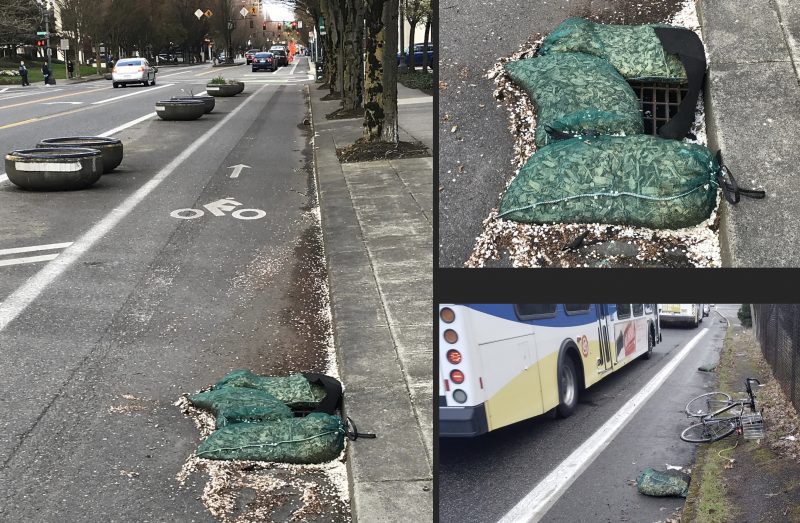
(Photos courtesy readers Steve and Ben)
“He slammed into one of these, fell to the ground, and tore open a nasty gash in his elbow that required a number of stitches at the ER.”
— Steve N.
We have a precious small amount of high-quality, smooth, clean and dedicated space for cycling. That’s why when people willfully encroach and degrade that space, we feel the need to raise an alarm about it.
Case in point are these bags we often see placed around storm drains. The drains themselves are often hazards for bicycle riders: They have grooves that can catch tires and they’re often set below-grade — meaning your bike drops down when you go over them. Most people avoid riding over storm drains, even though they often take up a foot or two of what’s already a relatively narrow space for cycling.
Add these bulky bags — which are often called bio-bags — and you’ve got real hazard.
The bags are used to manage stormwater runoff and control erosion and they are usually full of hard wood chips.
Reader Steve N. wrote to us last week after he saw them on NE Multnomah Boulevard in the Lloyd District. “Construction crews have placed some bio-bags directly in the bike lane,” he wrote, “which are challenging to see in daylight and nearly invisible at night, thereby creating a dangerous condition.”
Advertisement
Steve was spurred to contact us because his co-worker Ben crashed on these exact type of bags while cycling into downtown via SW 4th Avenue (by way of Barbur). Here’s what happened: “While merging into the traffic lane, he slammed into one of these, fell to the ground, and tore open a nasty gash in his elbow that required a number of stitches at the ER.”
The image below is where Ben hit the bag. Believe it or not this location (northbound on SW 4th just past the I-405 overpass) is a major gateway into downtown. Making matters worse is the fact that this bike lane is ridiculously narrow at only 3-4 feet wide…
And here’s the damage to Ben’s arm…
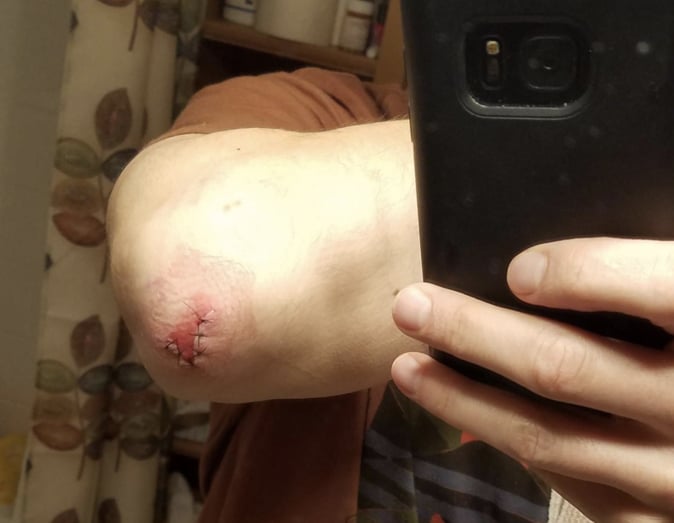
And the damage to his bike…
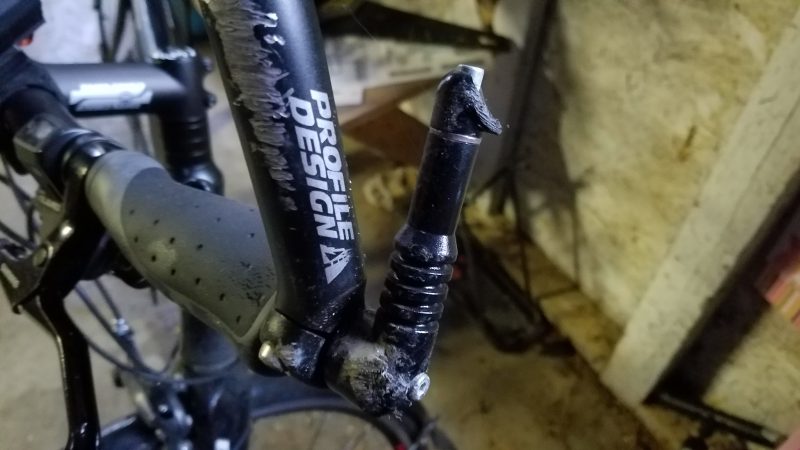
Ben said the bag he hit was in the middle of the bike lane. “This could have ended much worse for me,” Ben emailed, “if I had been going a bit faster or if the driver behind me had been less attentive.”
In Portland, contractors are responsible for taking “erosion control measures” during their projects. The Bureau of Development Services offers detailed guidelines on what types of bags are required and how to install them properly. Unfortunately, it appears as though these bags are completely within those guidelines.
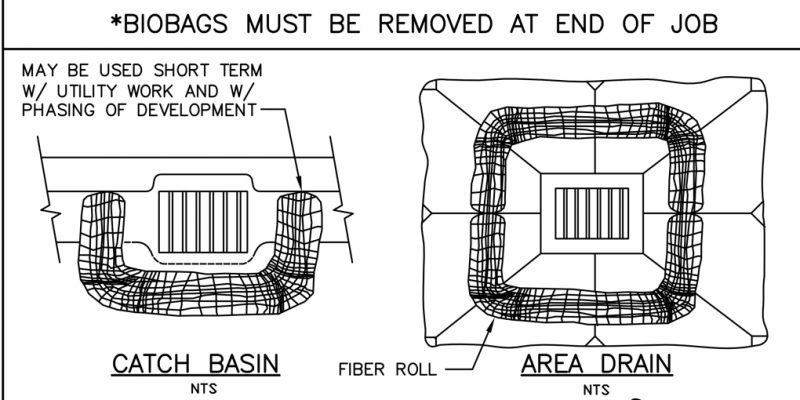

There’s another method that uses only fabric (photo, right) and is much less intrusive, but it appears BDS only requires that method for use on a temporary, 24-hour basis.
Steve and Ben happen to be civil engineers, so they should be good advocates to try and figure out a solution to this problem. They also plan to contact the City of Portland about their experiences. We’ll report back when — or if — they make any progress.
— Jonathan Maus: (503) 706-8804, @jonathan_maus on Twitter and jonathan@bikeportland.org
Never miss a story. Sign-up for the daily BP Headlines email.
BikePortland needs your support.



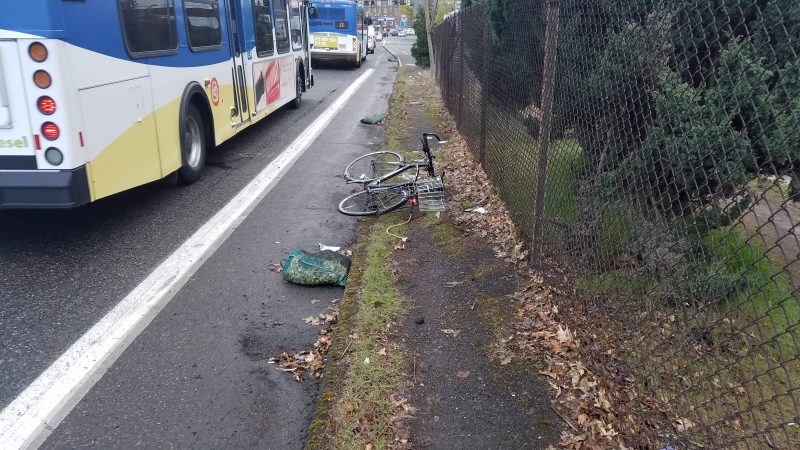
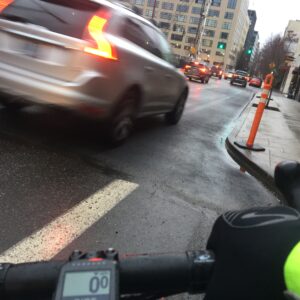
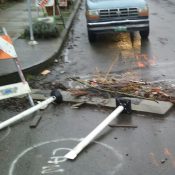
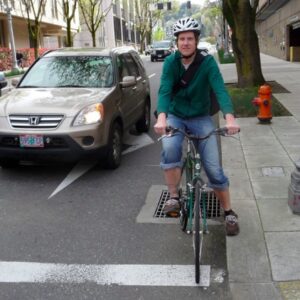
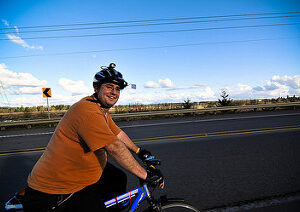
Thanks for reading.
BikePortland has served this community with independent community journalism since 2005. We rely on subscriptions from readers like you to survive. Your financial support is vital in keeping this valuable resource alive and well.
Please subscribe today to strengthen and expand our work.
Move them. If they keep getting moved enough, they’ll find another way. Same goes for anything placed in the bike lane.
I’ve been complaining to the city about these bags for years. They block half the bike lane when placed “correctly”, and after a car or two has knocked them around can block the entire thing. At some point someone is going to hit one in the dark, fall into the car lane, and get killed.
I figure they are there to protect fish. I’m not opposed to protecting fish, but I value human lives more highly.
I figure it’ll take someone getting killed to get the city to stop the city placing these things at this point, it’s sad
I’m not by nature an arsonist, but if idda been Ben, I woulda gone out there after bar hours with a can of gas and brought attention to the problem with fire.
Fu*k those bags. (*after job completion?! – WTF?)…can you imagine how many drivers would blow their stacks if a third of their travel lane was blocked by sand bags or something?
Somebody’s gonna die. And maybe already has…if on scene emergency responders don’t recognize the obstacle as such …it won’t go in the report unless a witness saw it. Not like the dead cyclist is gonna be sayin shit.
Could the city not require the fabric of the bag incorporate some small percentage of reflective fibers? It won’t keep them from being tossed around, but it would make them more visible to riders with headlamps.
At minimum, they should be bright colored and reflective. But really, they should not be there. I’d get sued if someone crashed because I put one of these in the street.
“Temporary”? I’ve seen these bags hanging out near construction sites for months at a time. E.g., the NE 21st Ave overpass over I-84.
If construction is occurring, they have to be in place.
I understand what you mean–that the City requires them. But that requirement isn’t necessary. There are other ways of preventing stuff from getting into the storm drains. And it’s also a decision (albeit perhaps made blindly) to value erosion control over human safety.
Slow down there. It’s unfortunate this individual got hurt. But is this really a problem? This is the first I’ve ever heard of someone having trouble with these.
From the comments, other people think it’s a problem.
If it’s happened to 100 other people, how would we even know? It would never be in the news unless there was a major injury or lawsuit. Much as I love bikeportland, the odds are still low that someone who was hurt would know or think to get the info to bikeportland.
It’s certainly not on the top of the list of world problems, but on the other hand it’s easy to fix. For just one example, people could remove them instead of leaving them there for months. I (and others from the comments) see them in place long after they fill up with silt and become useless, and they even are left long after they’re needed.
I NEVER ride over the drainage grates to begin with; one of my biggest pet peeves with this city’s bike lanes are that these double-wide drainage grates decrease the effective bike lane width by several feet, sometime down to only 12 to 18 inches.
PBOT claimed years ago that they would stop using the double wide drainage grates on roads with bike lanes, but that still hasn’t happened, and the double wide grates seem like the new standard.
Don’t be riding so fast that you can’t see/avoid these bags.
Better yet just take a car so you’re protected by a metal box!
With SW 4th Ave likely and logically to receive a protected bike lane in the near future it is the area beyond the bike on the ground that very much concerns me as a fatal flaw with regards to getting anyone other than the most able-bodied and confident to actually use such protected infrastructure off Barbur or Terwilliger. If you look beyond where Ben fell the situation becomes even worse as people riding bikes loose the bike lane and are then forced to merge into the middle of 4 lanes of machine traffic. Instead of coming up with a better solution several years ago when constructing the Orange Line PBOT/ODOT/TriMet agreed to construct a 1/2 block long raised curb so people on bikes cannot move to a safer space to the right. Most often the right 2 lanes have limited traffic as this is the offramp from I-405. That curb is another daily reminder of the middle finger people on bikes receive from their experience coming from SW to downtown. Yes, let’s fix 4th Ave, but don’t forget this fatal flaw. Fill in the gaps please!
Take the lane.
Cycling is so hard. Life is hard too. Tissues at all four way stops.
The City requires a whole slew of erosion control measures for projects that disturb the ground. These bags at storm drains are a last-in-line measure. The first lines of defense are avoiding soil disturbance when possible, and putting up erosion control barriers on the site (i.e. not on the street) to prevent any dirt from ever getting over the curb and into the street. If these are done correctly, there should be very little washing into the street.
So alternative possibilities are:
1. Do better inspection of on-site devices so they stop erosion sediment from ever reaching the street.
2. Allow the flat, fabric filters for long-term use, with a requirement to inspect and change them more often so they keep functioning.
3. Just skip the measures at storm grates, especially where bikes may be, knowing that the small gains in erosion control (very small if the on-site measures are done correctly) aren’t worth injuring cyclists.
How does the bag prevent erosion? Do they take the dirt that accumulates at the bag and place it back at the worksite? Or do they just remove bags and let the accumated dirt wash into the drain on the next rain. How much dirt are we talking about? When I see these it looks like they are blocking a few cups of dirt at most, or less, or none at all. If the issue is fish, isn’t the bigger problem from the carbon black created by cars? Why no carbon black filter.
Stormwater BMPs around construction sites are pretty important and they’re kind of a sum of all of the parts. Removing an aspect of the system defeats the purpose.
http://www.deq.state.or.us/wq/stormwater/docs/nwr/constrbmps.pdf
(Note: DEQ doesn’t want biobags used on paved surfaces, but the City does).
No it doesn’t. Removing one aspect of the system only defeats the purpose of that aspect. It doesn’t negate the value of the other components. If it did, that would mean removing the bags in the street at the drains would make all the onsite measures worthless. The onsite measures (devices plus practices) if done correctly will prevent almost all the sediment from reaching the drains.
yes, let’s not bypass the system when we could just do it properly…
http://www.oregon.gov/deq/FilterPermitsDocs/BMPManual.pdf
page 33 shows how you’re supposed to use an insert rather than a bag… page 34 states the bags shouldn’t be used in traffic areas or on paved surfaces…
so if you see these bags in the road then the construction company is doing it wrong…
use the city reporter app to send a notification about the needed change…
Thanks for that link. They recommend the below grade filter bags, which are more effective, require very little maintenance, and are much safer for all road users. Why isn’t this being done? It’s because the city bends over backwards for developers, ignoring the safety and quality of life of residents.
Years ago, Walmart got in a lot of trouble when some of its contractors didn’t manage their stormwater properly. In addition to fines and a supplemental environmental project, they had to pay civil/environmental consultants a lot of money to audit their contractors (without notice) for several years afterwards.
https://www.epa.gov/sites/production/files/2013-09/documents/walmart2-cd.pdf
Yes, there are penalties for not providing erosion control, as their should be. Nobody is saying contractors shouldn’t provide the bags if they’re required. They’re saying the regulatory agencies should consider alternatives to requiring these bags, and perhaps things like inspecting to make sure they’re not left there after they’re needed, not knocked further into the street, etc.
And think of this–if a contractor left small black garbage bags, or tool boxes, or construction materials in the street, he could be fined, because those are safety hazards. Just because these bags are serving a purpose doesn’t mean they’re not the same safety hazard. Your tire doesn’t care what’s inside the bag.
Good luck getting BES, DEQ, and EPA to all change their tune.
the DEQ’s manual says not to use these bags on a road like this… should be easy enough to point them to their own documentation for proof of needed change…
You’re hysterical. Not in the “funny” sense.
Why?
admittedly this isn’t helpful but for anyone keeping score:
2 weeks ago, Mi Ae Lipe momentarily suggests people on bikes wear hi-vis clothing, gets pilloried by handful:
> If you can’t see bikes, YOU’RE DRIVING TOO FAST!!
> reflective clothing is too expensive!!
> why are cars allowed to be black??
now..with prospect of drainage bags that could be hit by person on bike trucking too fast or being inattentive:
> least city could do is add reflective material
reflective ≠ hi-viz.
The biobag might be dressed for a night on the town.
Why are cars allowed to be black?
Maybe because the are required to have head lights, tail lights and side markers.
So are bikes… well, at least the head & tail lights, but generally do come with reflectors on the spokes…
I don’t think anyone was saying cars shouldn’t be allowed to be black. They were saying if people are going to bring up pedestrians not wearing high-visibility clothing, it’s fair to question why those same people don’t question black cars. Black cars may have headlights and reflectors, but they are still harder to see than other cars in some conditions.
I also don’t think someone walking in a crosswalk is comparable to a dark bag a few inches high in a gutter as far as visibility goes.
And while yes, someone on a bike SHOULD see those bags–just as drivers SHOULD see pedestrians crossing the street–but since we know people make mistakes, it makes sense to take simple steps (such as not using those bags in the street) to lessen the damage those mistakes cause.
And it sounds from info in some other comments that perhaps there should have been a different, safer device use, and perhaps also legally-required signage, so (while I’m not a fan of requiring the bags to be reflective myself) proposing that they be reflective is very much in line with those other existing rules that aim at accomplishing the same increased safety as would reflectivity.
So we should regulate what pedestrians wear the same way we regulate cars. You can wear black, as long as you have lighting designed to make you visible at night. We regulate commons sense with vehicles yet don’t practice it with those most vulnerable.
Because humans walking are the same thing as cars.
Humans have walked for 3.7 million years or so without being forced to wear lighting or special clothing, then someone invents a speedy metal box to travel in and suddenly we need to start getting humans to dress up.
Yes, let’s do that. But then once pedestrians put on their lights, then they should be allowed to take the lane, using any traffic lane in any street that allows vehicles. In fact, maybe require them to be in the street, saving sidewalks for people who don’t have their lights and licenses.
Cracked me up.
Bio bags are only one of many hazards that part of the cycling environment. Cracks, holes, broken glass, a wide range of natural and manmade debris, metal grates, oil slicks, animals, and other things are inherent to the cycling environment.
Crashing into bio bags is a sign that the rider is not prepared for a wide variety of common threats and needs to adjust his/her riding style.
If there’s a better way to mitigate runoff, let’s advocate for that. But the vigilante action advocated by some that damages the environment just because they’re annoyed at having to pay attention to an easy to detect and avoid hazard is nonsense.
I’v seen the limits of advocating for better ways to solve simple problems. Here’s my take:
I move every garbage can blocking a bike lane into a driveway not because I can’t see them or because I can’t avoid them, but because they shouldn’t be blocking a lane of traffic in the first place and I don’t think every kid riding to school should have to take the lane on some busy street just so some homeowner can enter/exit their driveway unhindered.
The people putting bio-bags, garbage cans, piles of leaves etc into bike lanes aren’t doing it for a lack of better alternatives, they’re doing it because it’s the easiest and most convenient way to solve the problem they have and the city lets them do it. They don’t know and/or care that it creates a problem for others as long as their problem is solved. Heck, they don’t even consider a bike lane as a traffic lane at all!
This won’t change until the offending party has some skin in the game. I’d rather it be from vigilante actions than because some kid took the lane and got hit.
Bio bags aren’t done out of contractor convenience. They are required. Big difference.
Removing properly placed ones is basically vandalism.
The real vigilante in me would create a proper (and required) Traffic Control Plan and implement it so that the requirements are met for both erosion management and traffic management. Unfortunately, I don’t have the signs and other stuff to do that.
Here’s an excerpt from the TCP Design Manual for Oregon with regard to “shifts in bicycle and/or pedestrian facilities”:
“Proper merging and shifting taper lengths; and, inclusion of appropriate channelizing or barrier systems will provide a satisfactory degree of safety and predictability for road users within the Transition Area.”
and:
Bicycle–specific signing should be used “When an existing bicycle facility (e.g. bike lane, multi-use path) is impacted by construction and cyclists must share a traffic lane, or the shoulder width is narrowed to 3-feet or less.”
there must be temporary signs.”
I think we can all agree that if the above requirements had been met we wouldn’t have been reading this story.
The manual is a good read (although it’s frustrating how little it is actually followed):
http://www.oregon.gov/ODOT/Engineering/Docs_TrafficEng/TCP-Design-Manual_v13.pdf
What about crashing into a black gate put up to intentionally block a path? What about hitting an unpainted speed bump (in a car or on a bike)? What about driving into an uncovered manhole?
I think there is a fundamental assumption that cars pretty much can’t go slower than 20, and that bikes can’t go above 10. Assuming that “cars” are going to be traveling fast leads to measures such as minimizing obstructions to “car” lanes and using things like cones (reflective ones) and signs to prepare drivers well in advance of any intentional path impediments. The assumption that bicyclists either don’t exist or are essentially walking leads to hazards and blockages being casually created and left for bicyclists to discover in often unfortunate and unexpected ways.
Kyle, there is a better way. It’s detailed in the DEQ report that Spiffy linked to. It’s called the “catch basin insert bag.” It’s a filter bag that sits under the grate inside the drainage area.
From the DEQ report:
“This type of inlet protection (catch basin insert bag) is highly recommended for areas where vehicle traffic occurs as it will result in significantly less maintenance compared to most other inlet protection methods.”
Also:
“Biobags have the least retention of any of the erosion controls but can serve a valuable purpose in retaining larger particulate sizes when properly maintained. Unfortunately, they are seldom maintained and are quite frequently damaged by traffic shortly after installation. Also, at the time of removal, very few are removed properly. If the sediment that has dropped out behind the bags is not cleaned up, then the purpose of the inlet protection is lost as the next rain event will wash this sediment into the storm drainage system.”
I am angry that contractors do not follow the best practice recommendations from the DEQ, and that the city does nothing to require them to do so.
There is a Vancouver, WA company that sells filter bags that fit within the grates of storm drains instead of sitting out on top of the road. Can’t remember their name right now, but dealt within 10+ years ago when they obtaining and defending patents for this cool solution.
Why do our local ‘bike friendly cities’ still utilize this type of storm water drain design on arterials with bike lanes…should not the curb inlets be inset into the curb face?
This design can possibly be deployed more widely than it is, but viable storm drain design depends on the specifics in that area. For example, curb cuts won’t work with more than inclines because the water will flow past the drain.
Good drainage is important, and some road areas already have torrents of water flowing when it rains. Anyone who has problems with bio bags isn’t going to do better riding through water that hides cracks/holes even from the eagle eyed and contains debris that can cause loss of control.
Depends on whether the roads were designed and built with bike lanes or the bike lanes were retrofitted to existing roads. You’re always going to have these issues with changing old infrastructure.
But is new infrastructure always–or even usually–being built with the better storm drain design?
on some old streets the storefronts have basements that extend to under the sidewalk… so you would need to put a drain pipe in their basement to hide the drains under the curbs… new construction could absolutely do this…
this is also why you should never drive a heavy truck onto a sidewalk where there isn’t a driveway… you don’t know if it’s earth or if it’s hollow under there…
RE: Erosion controls. These bags are required by permit for soil disturbances during construction. The specifications say that they are to be removed upon final construction inspection. I often see that this does not occur, and has to be brought to PBOT’s attention whenever we see an obstruction in the bike lane.
To PBOT’s credit, I have complained a couple of times for construction limitations (misplaced fencing, dirty or muddy surfaces, debris) imposed on bike lanes and they have been good about correcting them. Once its brought to their attention, it becomes a liability issue to the landowner as well as the constructor’s insurance carrier.
I believe that the bags should be orange coned for vertical visibility when in use, or better, a designated bike detour around them should be enforced and coned. Haven’t taken up that issue yet…
The gaps in that grate look wide enough to jam a road bike wheel. If he couldn’t see the bags, he wouldn’t have seen the grate either.
it looks like they’re using both the black mesh inserts recommended for paved busy streets AND the green bio-bags recommended for rural areas with low traffic…
I’d complain to get the excess bio-bags removed due to their being a hazard…
Perhaps if their colors were brighter, and if they had reflective materials built into them it *MIGHT* make them safer. Also, it wouldn’t be a bad idea if traffic cones would be set up next to them and/or shy lines (marking paint) were help increase awareness of them.
(think florescent colors that wouldn’t match fall leaves, and a few strips of reflective tape incorporated into the bags).
BTW… I’m still in China. Did PDX ever do anything about those storm drains On or around PSU?
If not, and anyone ever gets hurt, remember that I was documenting these things since the beginning of the decade. I’ll be willing to testify, but I’ll need round trip tickets from the PRC, and compensation for the lost time at work.
Those little things… I am sorry he got hurt. It is the little things, since we are already relegated to the gutter, and the gutter is where most folks think it’s okay to stash their detritus and other problems. So many little things we have to deal with. My favorite is the sudden orange diamond sign that shows up in the bike lane telling motorists to watch out for cyclists in the road….you got to put that first sign right in the bike lane, sort of force the issue.
THATS WHY I RIDE A DERESTRICTED FULL SUSPENSHUN FAT TIRE EMTB TURNS THOSE BAGS INTO JUMPS
Can you jump these things too?
https://portlandtribune.com/go/42-news/384420-273245-man-sues-city-after-bicycle-crash-
The problem isn’t how they keep silt out of the storm drains; the problem is that the storm drain inlets (along with the necessary erosion control measures) are located in the bike lane. A bike lane should ideally be dedicated space, like the auto lanes, and not a space shared with the drainage system.
Actually the problem IS how they keep silt out. The measure that uses fabric under the grate doesn’t create the safety hazard that the bags create. It would have prevented the crash described in the article.
HA!
THE DEVIL IS IN THE DETAILS….
“…place bags of wood chips outside storm drains located (-> within <-) the project area."
https://www.portlandoregon.gov/bes/article/531160
(WITHIN) THE PROJECT AREA??
I DON'T THINK SO….
THE "PROJECT AREA" IS ACROSS THE STREET.
THEY'RE NOT SUPPOSED TO BE THERE.
How is “project area” defined in this context?
Stormwater control measures are often on-site of the construction project and some are placed off-site and downstream to protect inlets in the event of a gully washer, as we call them here in Tucson, AZ. The issue at hand is how to protect the storm drain inlets without interfering with traffic or bicyclists. Catch basin filters function to keep sediment and debris out of the storm drain and and are set below the grating (see https://cleanwayusa.com/catchbasin/). Removing them requires more effort as the grate needs to be removed before the collected material is disposed. The extra effort seems well worth the prevented injuries and loss of life.
I am working on the project associated with the Biobags in the roadway. I was shown this website and the post associated with this hazard to bicyclists. I looked for high visibility Biobags from suppliers of this product and they are not made. My company likes to think outside the box when problems like this come up. My sister (who works as purchase agent for us) found orange bags that are used by fruit companies so we bought them and put them over the green bags creating HIVIS biobags!
I’m sorry I can only “recommend” this once.
Thank you, Brent!!! Come join us on a bike ride sometime! Pedalpalooza is coming…
Thanks for listing to my suggestion… Please tell me that you’re going to add some reflective tape to those to make them even more visible at night.
Correct me if I’m wrong, but those go over storm drain grates, yes? Meaning if the rider hadn’t hit the ‘bag’ then he would have gotten his front tire stuck in the grate? Meaning the ‘bag’ saved him from more serious injury?
You won’t get your front tire stuck in most storm grates.